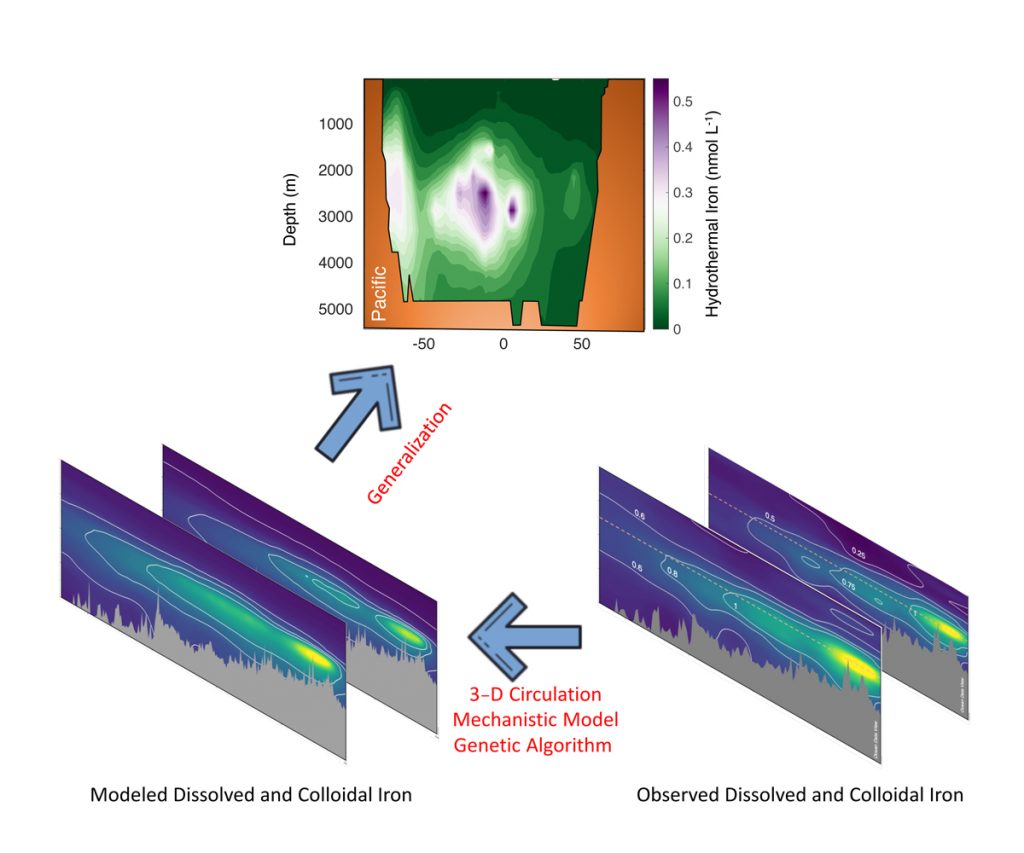A new model simulates the speciation and dispersion of hydrothermal iron
Roshan and collaborators (2020, see references below) present new observations of dissolved iron (Fe) and its physical speciation in the South Pacific (along GEOTRACES GP16 section), and develop a new mechanistic model of hydrothermal Fe dispersion. They propose that Fe is released from hydrothermal vents as large inorganic colloids, and is gradually transformed to organic forms further away from the vents. Reversible scavenging of Fe colloids by organic particles facilitates the long-range transport of hydrothermal Fe, but also traps dissolved Fe in deep water masses. Roshan and collaborators apply their new mechanistic model to the global ocean using a data-constrained ocean circulation and Helium-3 (3He) sourcing model (DeVries and Holzer, 2019). They find that 3-4% of hydrothermal Fe from global vents (and only 1% of hydrothermal Fe from the East Pacific Rise vents) makes it to the surface ocean. They also find that the majority of the Fe that reaches the surface ocean originates from the Southern Ocean vents, which may drive sporadic blooms of plankton in the Antarctic waters as proposed by Ardyna et al. (2019, see science highlight). Overall, Roshan and collaborators suggest that the impact of hydrothermal iron source on biological productivity is limited exclusively to the Southern Ocean, and may be smaller than previously thought.

References:
Roshan, S., DeVries, T., Wu, J., John, S., & Weber, T. (2020). Reversible scavenging traps hydrothermal iron in the deep ocean. Earth and Planetary Science Letters, 542, 116297. DOI: https://doi.org/10.1016/j.epsl.2020.116297
Roshan, Saeed; DeVries, Tim; Wu, Jingfeng; Weber, Thomas; John, Seth G. (2020): Modeled Hydrothermal Dissolved Iron. figshare. Dataset. DOI: https://doi.org/10.6084/m9.figshare.12442847.v1
Ardyna, M., Lacour, L., Sergi, S., d’Ovidio, F., Sallée, J.-B., Rembauville, M., Blain, S., Tagliabue, A., Schlitzer, R., Jeandel, C., Arrigo, K.R., Claustre, H. (2019). Hydrothermal vents trigger massive phytoplankton blooms in the Southern Ocean. Nature Communications, 10(1), 2451. DOI: https://doi.org/10.1038/s41467-019-09973-6
DeVries, T., & Holzer, M. (2019). Radiocarbon and Helium Isotope Constraints on Deep Ocean Ventilation and Mantle‐3He Sources. Journal of Geophysical Research: Oceans, 124(5), 3036-3057. DOI: https://doi.org/10.1029/2018JC014716
